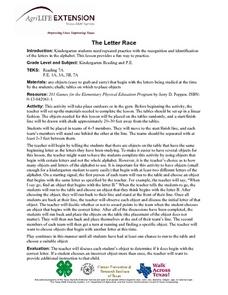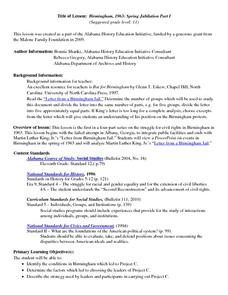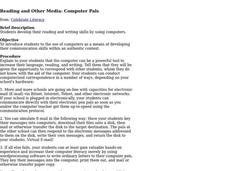Curated OER
CH-ch-ch-ch, CH-ch-ch-ch, CHOO-CHOO!
Students identify the digraphs in written and spoken language. After a brief discussion of the combinations of /c/ and /h/ that comprise th /ch/ digraph, students practice identifying initial and final placement of the digraph /ch/ in...
Curated OER
Key Pals
Second graders analyze the proper form of friendly letters and write emails to a key pal. In this friendly letters and email lesson, 2nd graders discuss sending friendly letters and view examples of the letter format. Students then...
Curated OER
The Letter Race
Students practice identifying the letters in the alphabet. They use this activity in phyical education class and run to each letter when they identify it correctly. They also state the name of different objects throughout the room.
Florida Center for Reading Research
Picture the Word
This is an excellent way to make onset and rime visual for beginning readers. They examine CVC-word picture cards that are all missing the first letter. Using plastic letters (or whatever you have), they complete each word and record it...
Curated OER
3-D Cell Model
Life science laureates choose a plant or animal cell to construct a model of as an at-home project. This handout provides guidelines, suggested materials, and a grading rubric for their reference. A full-page letter to parents is also...
Curated OER
"Ehhh" I can't hear you!
Students practice writing, sounding out, and identifying words using the short "e" sound. They listen as the teacher reads a tongue twister emphasizing short "e" beginning sounds. The stuents then participate in an activity in which...
Curated OER
Eva's Code
Students understand the importance of punctuation in a sentence. In this codes lesson, students write a pen pal letter using codes for the punctuation. Students send a key to break the code if needed.
British Council
Unit 1: Email addresses
E-mail is a communication sensation! Young job seekers discover the essential knowledge required to thrive in an online world in the first of a nine-part series of career education and skills lessons. The resource covers e-mail address...
Curated OER
Test Your Speaking Skills-- Tongue Twisters
For this language and speech worksheet, students learn to articulate similar sounds by pronouncing tongue twisters. There are 32 to try and are organized by the beginning letter.
Alabama Department of Archives and History
Birmingham 1963: Spring Jubilation Part 1
As part of a study of the 1963 quest for civil rights in Birmingham, Alabama, class members view a PowerPoint that details the struggle and analyze Martin Luther King, Jr.'s "Letter from a Birmingham Jail."
Curated OER
Animated Alphabet
Students explore English by completing an interactive language history activity. In this word recognition lesson, students discuss word formations and the phonetic relationship between letters. Students identify the origin of individual...
Curated OER
Antonyms 5
Depending on the current level of your native and non-native speakers, this might be a resource worth using. The 10 vocabulary words are difficult, but it's the multiple-choice options that might be daunting to your high schoolers!...
Alabama Learning Exchange
Phonics lesson for -ew and -oo
First graders identify letters and sounds associated with -ew and -oo sounds. Each learner receives a stack of cards containing these sounds, and they must determine whether the word uses the -ew or the -oo sound. This could easily...
C-SPAN
Electoral College Pros/Cons and Alternatives
If every vote counts, why do we need the electoral college? Middle and high schoolers study the Constitutional precedent of the electoral college, as well as its place in historical and modern elections, with an engaging social studies...
Curated OER
Division of Syllables
Study diphthongs in the Spanish language. This resource contains a lot of information, so consider printing one for each learner to reference and walking them through it as a class. There is a short exercise at the bottom of the page to...
Houghton Mifflin Harcourt
Family and Friends: Extra Support Lessons (Theme 4)
Family and Friends is the theme of a unit offering extra support lessons. Follow each lesson plan's teach, blend, guided practice or practice/apply routine to reinforce concepts such as clusters, responding to reading, drawing...
Houghton Mifflin Harcourt
Let’s Count!: Extra Support Lessons (Theme 5)
In a themed series of lessons and activities, beginner readers are given extra support in reading through chants, games, and practice worksheets.
Curated OER
Applying Phonetic Principles
Young readers develop their phonetic skills by using a nifty tool called a word pocket. They use the tool to help them organize individual letters that they have at their desks to spell entire words and to construct beginning and ending...
Curated OER
Computer Pals
Students are introduced to using computers as a means of developing communication skills within an authentic context. Students communicate with each other and share ideas via e-mail or other types of computer appllications.
Curated OER
B at the Double
Hone the research skills of your High school pupils through this online resource. They must find the answers to these questions using the Internet. All answers begin with the letter b.
Curated OER
Lights on for Reading!
Students practice the art of reading a piece of literature left to right by relating the beginning letters to common words from their environment. They practice holding and reading the book, "The Lightbulb," by Joseph E. Wallace and...
Curated OER
Word Patterns: Forming Words
In this word pattern worksheet, students add beginning letters to a series of the same ending letters to form words that have the same word endings.
Curated OER
The Alphabet of Coins
Young scholars use letter/sound relationships of initial consonants to complete sentences that follow a given repeating pattern. These sentences be based on coin terms found on the U.S. Mint H.I.P. Pocket Change™ Web site.
Curated OER
Rock N Roll Philosophy
In this philosophy worksheet, students identify the names of songs when given the first letter of each word. This one-page worksheet contains 28 clues. Answers are provided at the bottom of the page.























